Executive Assessment Mock Test - 2 - GMAT MCQ
30 Questions MCQ Test - Executive Assessment Mock Test - 2
Th e graph shown below is a scatter plot with 48 points, each representing the number of radio ads per hour run by a company each day over 48 months, and the corresponding monthly sales revenue that the company earned. The sales revenues, measured in thousands of dollars, were tallied on the last day of each month that the ads were run. The solid line is the regression line, and the dashed line is the line through the points (1, $20,000) and (6, $50,000). Select the best answer to fi ll in the blanks in each of the statements below based on the data shown in the graph.
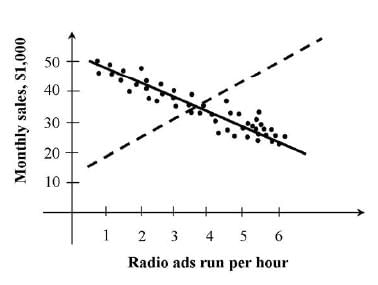
Q. The number of months in which the company generated more than $50,000 of revenue is closest to ________ percent of 48.

Th e table below gives information on the total inventory in 2010 and the total items sold by an international furniture manufacturer over a three-year period, from 2008 to 2010. The 19 furniture items were included in the table because they fall among the top 25 items produced by the company in terms of both total inventory and total items sold. In addition to listing the total inventory and total number sold for each furniture type, the table also gives the percent increase or decrease over the 2009 inventory and 2005–2007 sales numbers and the rank of each furniture type for total inventory and total items sold.
Sorted by Percent Change in Inventory (Column 5)
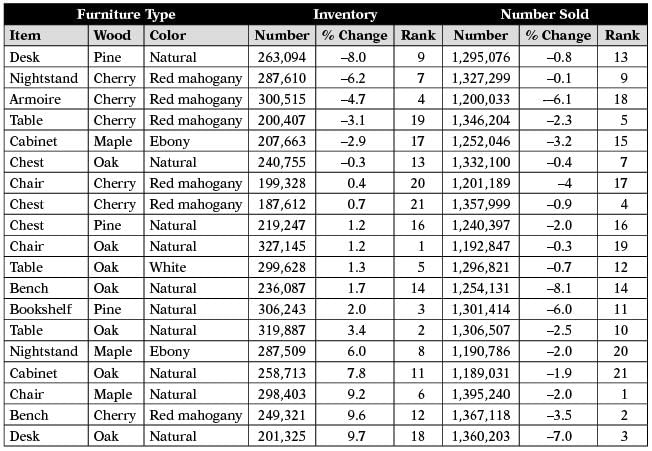
Sorted by Rank of Inventory (Column 6)
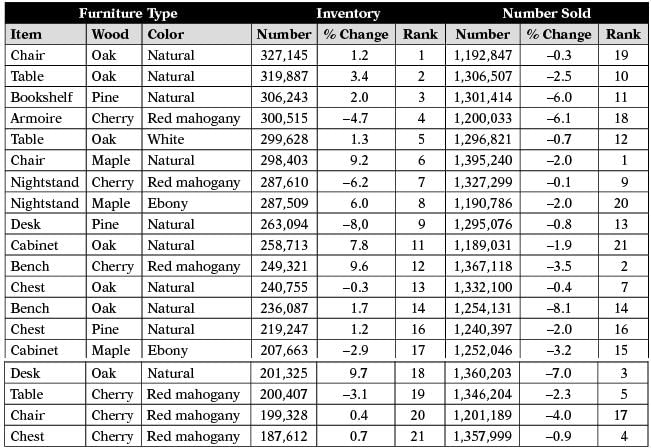
Sorted by Percent Change in Number Sold (Column 8)
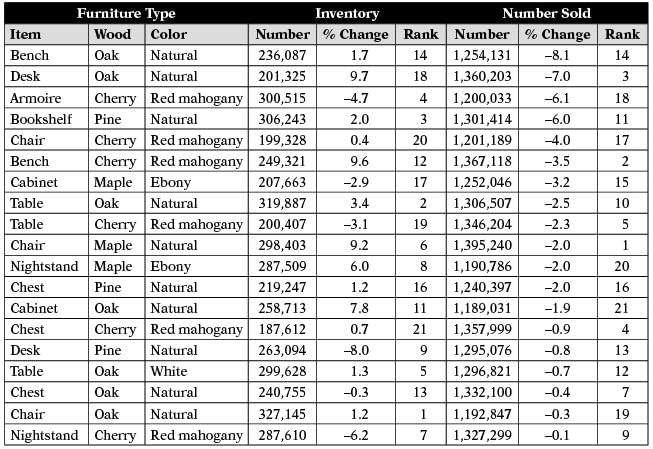
Sorted by Rank of Number Sold (Column 9)

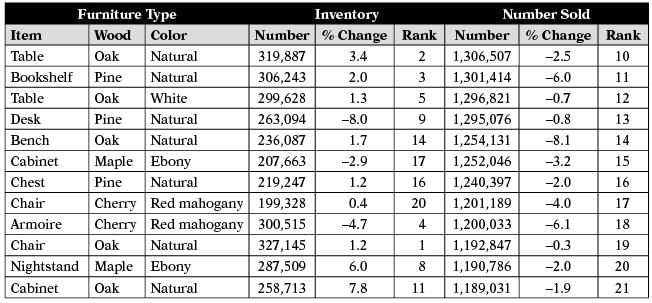
Q. Review each of the statements below. Based on information provided in the table, indicate whether the statement is true or false.
1. Exactly 50 percent of the furniture items that experienced a decrease in both total inventory and total items sold are Red mahogany.
2. The furniture type experiencing the greatest percentage increase in total inventory from 2009 to 2010 also experienced the greatest percentage decrease in the total number of items sold.
3. The furniture type with the highest rank based on total inventory is the same as the type with the highest rank based on total items sold.
4. The total inventory of Cherry Red mahogany Tables in 2009 was approximately 206,400.





Directions: Read the sources below before answering the question that follows.
E-mail 1—E-mail from division director to donations coordinator August 10, 9:37 a.m.
Yesterday I spoke with the computer training lab administrator to update him on the status of donations for the school district’s computer donations drive. He extended the donations deadline for another week, until next Tuesday. Are we on track to receive enough donations from students’ families to meet our goal of computers for the new training lab? Do we need to extend our request to local businesses too?
E-mail 2—E-mail from donations coordinator in response to the division director’s August 10, 9:37 a.m. message
August 10, 10:04 a.m.
To date we have received 40 computers. We need 100 computers donated to meet our goal for the new training lab. We have requested help from all of the students’ families, so we should invite local businesses as well. In all of our past drives, including this one so far, we have received donations from about 20 percent of those who received requests. (Of course, we might always receive more or less than that average, so we should consider the possibilities of not meeting the goal or overspending the budget for the thank-you event.) Each individual or organization donating a computer will receive two invitations to our thank-you event to celebrate the opening of the lab. Refreshments and supplies for the event are expected to run $20 per person. What is the total budget for the thank-you event?
E-mail 3—E-mail from division director to donations coordinator in response to the donation coordinator’s August 10, 10:04 a.m. message
August 10, 10:35 a.m.
The budget for the thank-you event is fi xed at $4,000. This would allow us to accommodate 2 attendees for each of the 100 computers donated. The budget is fi rm, so we should take care to ensure that the event costs stay within this amount. Although we do not have resources to extend the budget, if necessary we could determine ways to reduce the cost per person if we receive more donations than the original goal amount.
Q. Suppose that the donations coordinator requests computer donations from 400 local businesses. If all the information in the three e-mails is accurate, the number of attendees that will be invited to participate in the thank-you event is closest to:
E-mail 1—E-mail from division director to donations coordinator August 10, 9:37 a.m.
Yesterday I spoke with the computer training lab administrator to update him on the status of donations for the school district’s computer donations drive. He extended the donations deadline for another week, until next Tuesday. Are we on track to receive enough donations from students’ families to meet our goal of computers for the new training lab? Do we need to extend our request to local businesses too?
E-mail 2—E-mail from donations coordinator in response to the division director’s August 10, 9:37 a.m. message
To date we have received 40 computers. We need 100 computers donated to meet our goal for the new training lab. We have requested help from all of the students’ families, so we should invite local businesses as well. In all of our past drives, including this one so far, we have received donations from about 20 percent of those who received requests. (Of course, we might always receive more or less than that average, so we should consider the possibilities of not meeting the goal or overspending the budget for the thank-you event.) Each individual or organization donating a computer will receive two invitations to our thank-you event to celebrate the opening of the lab. Refreshments and supplies for the event are expected to run $20 per person. What is the total budget for the thank-you event?
E-mail 3—E-mail from division director to donations coordinator in response to the donation coordinator’s August 10, 10:04 a.m. message
The budget for the thank-you event is fi xed at $4,000. This would allow us to accommodate 2 attendees for each of the 100 computers donated. The budget is fi rm, so we should take care to ensure that the event costs stay within this amount. Although we do not have resources to extend the budget, if necessary we could determine ways to reduce the cost per person if we receive more donations than the original goal amount.
Q. Suppose that the donations coordinator requests computer donations from 400 local businesses. If all the information in the three e-mails is accurate, the number of attendees that will be invited to participate in the thank-you event is closest to:
The graph below is a bar graph with seven bars, each representing the number of complaints received by a telephone company from its new customers. The customers received follow-up calls anywhere from one to seven weeks after placing their orders. The customers were grouped by follow-up call timing, and the number of complaints was recorded for each group over a one-year period. Select the best answer to fi ll in the blanks in each of the statements below based on the data shown in the graph.
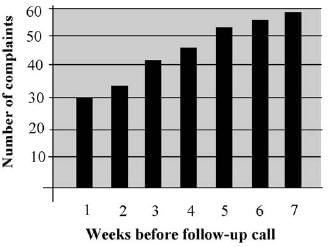
Q. The number of complaints made by customers who received a followup call one week after placing their orders is closest to ________ percent of the number of complaints made by customers who received a followup call seven weeks after placing their orders.
The table below gives information on the total number of tickets sold and the total sales revenue earned by a touring performance act in 2010. The 19 tour cities included in the table were among the top 30 cities on the tour in terms of both total numbers of tickets sold and total sales revenue. In addition to listing the total tickets sold and total sales revenue for each tour city, the table also gives the percent increase or decrease over the 2009 numbers and the rank of each tour city for total tickets sold and total sales revenue.
Sorted by Percent Change in Tickets Sold (Column 5)
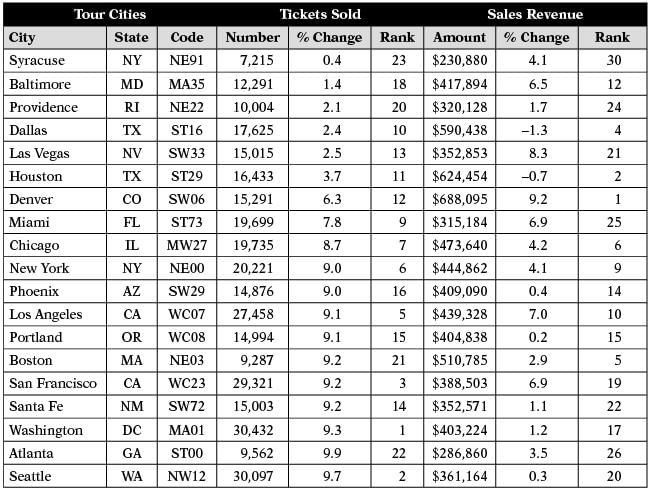
Sorted by Rank of Tickets Sold (Column 6)
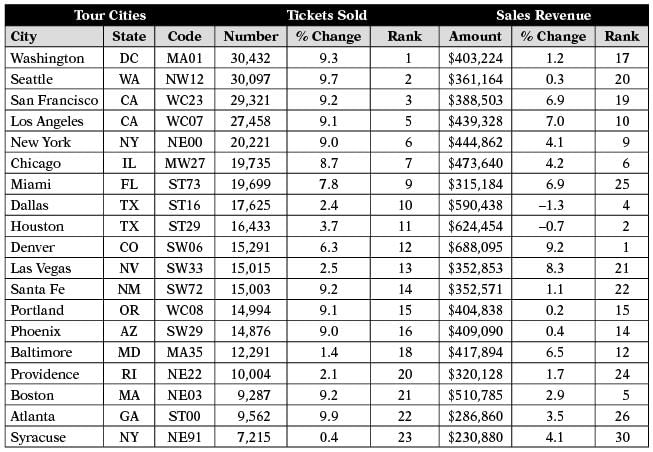
Sorted by Percent Change in Sales Revenue (Column 8)
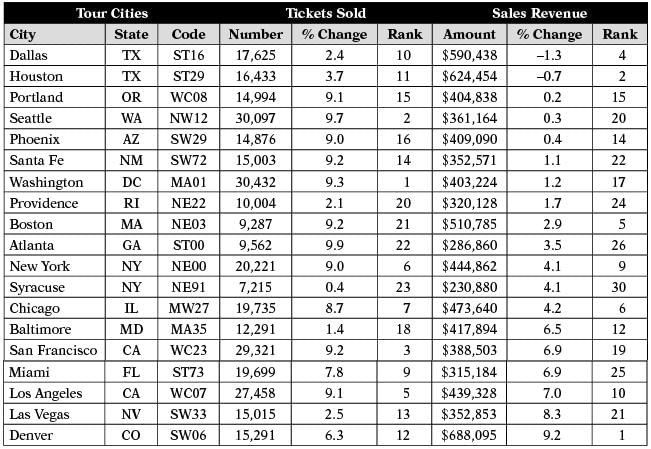
Sorted by Rank of Sales Revenue (Column 9)
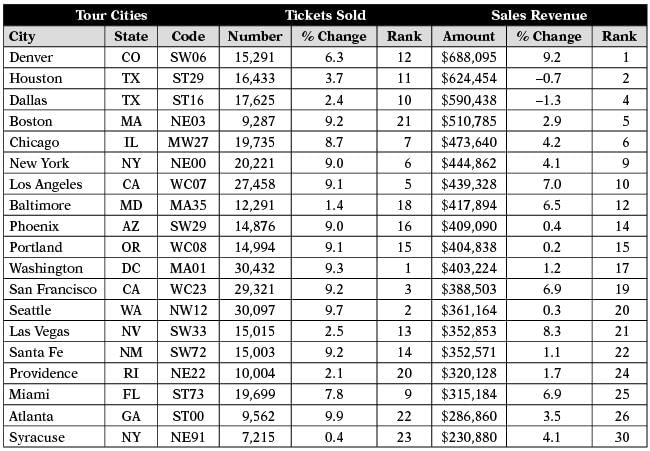
Q. Review each of the statement below. Based on information provided in the table, indicate whether the statement is true or false.
The tour city with the median rank based on total tickets sold is the same as the city with the lowest rank based on total sales revenue.
The table below gives information on the total number of tickets sold and the total sales revenue earned by a touring performance act in 2010. The 19 tour cities included in the table were among the top 30 cities on the tour in terms of both total numbers of tickets sold and total sales revenue. In addition to listing the total tickets sold and total sales revenue for each tour city, the table also gives the percent increase or decrease over the 2009 numbers and the rank of each tour city for total tickets sold and total sales revenue.
Sorted by Percent Change in Tickets Sold (Column 5)
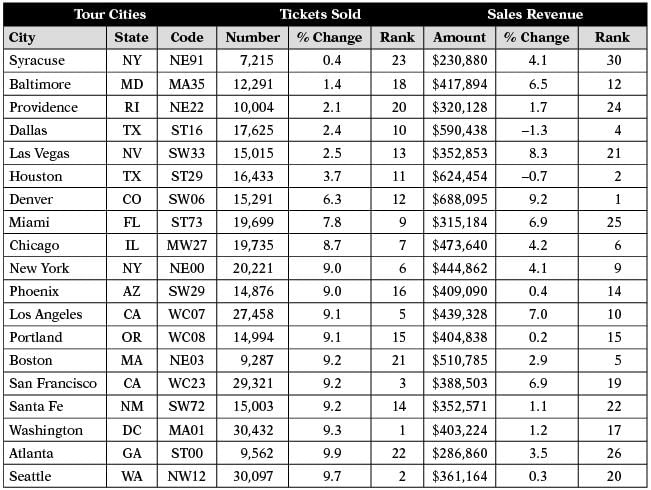
Sorted by Rank of Tickets Sold (Column 6)
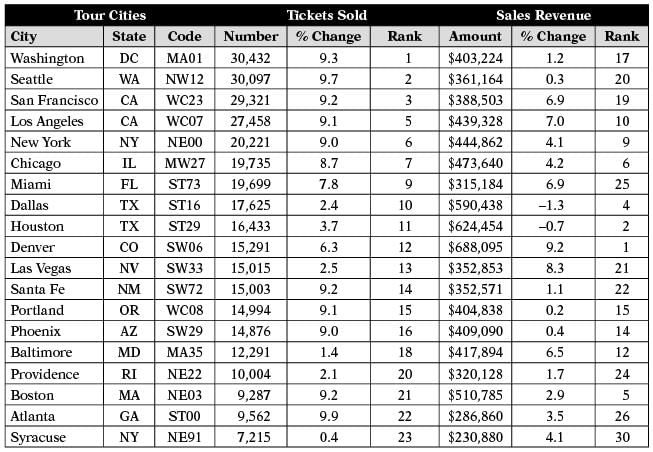
Sorted by Percent Change in Sales Revenue (Column 8)
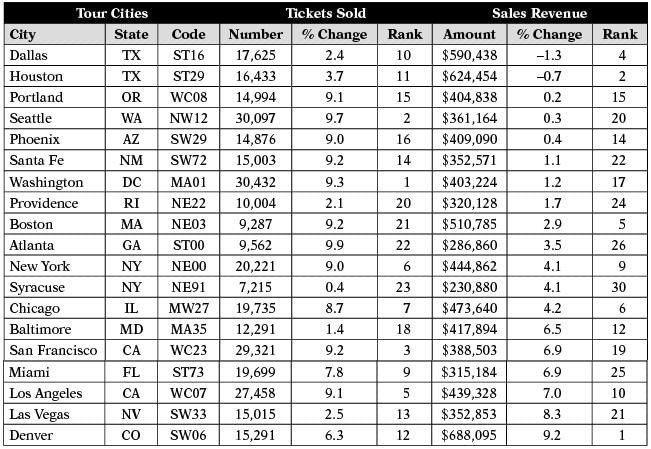
Sorted by Rank of Sales Revenue (Column 9)
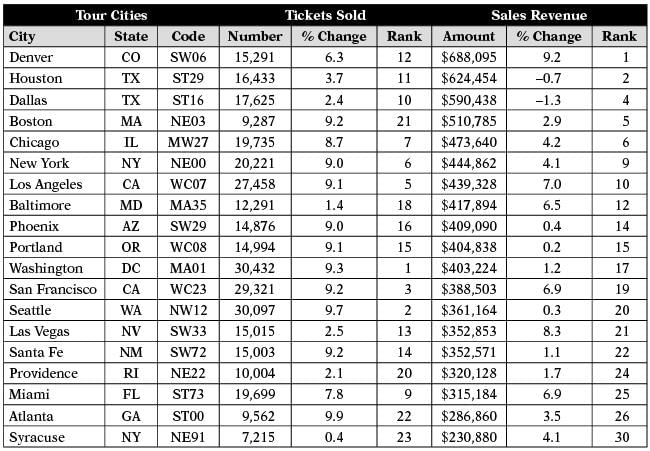
Q. Review each of the statement below. Based on information provided in the table, indicate whether the statement is true or false.
The total number of tickets sold in Providence, RI, in 2009 was approximately 12,000.
The table below gives information on the total number of tickets sold and the total sales revenue earned by a touring performance act in 2010. The 19 tour cities included in the table were among the top 30 cities on the tour in terms of both total numbers of tickets sold and total sales revenue. In addition to listing the total tickets sold and total sales revenue for each tour city, the table also gives the percent increase or decrease over the 2009 numbers and the rank of each tour city for total tickets sold and total sales revenue.
Sorted by Percent Change in Tickets Sold (Column 5)
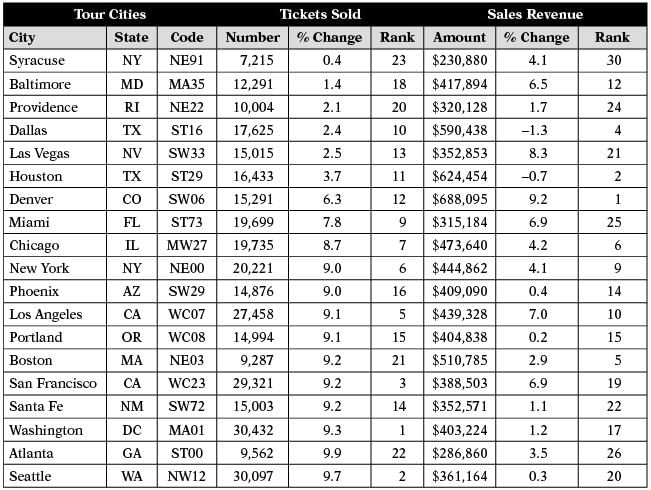
Sorted by Rank of Tickets Sold (Column 6)
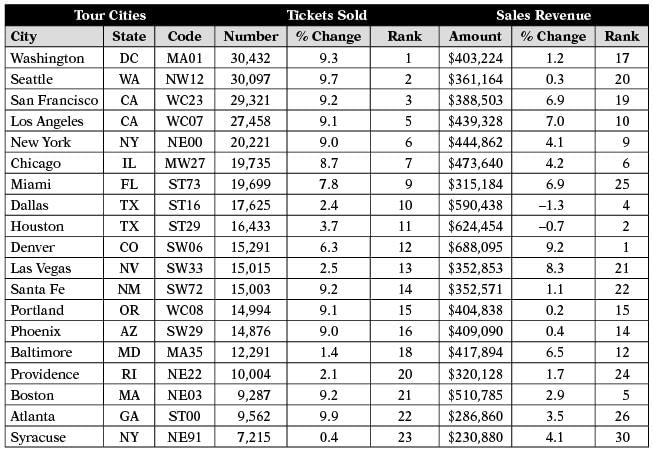
Sorted by Percent Change in Sales Revenue (Column 8)
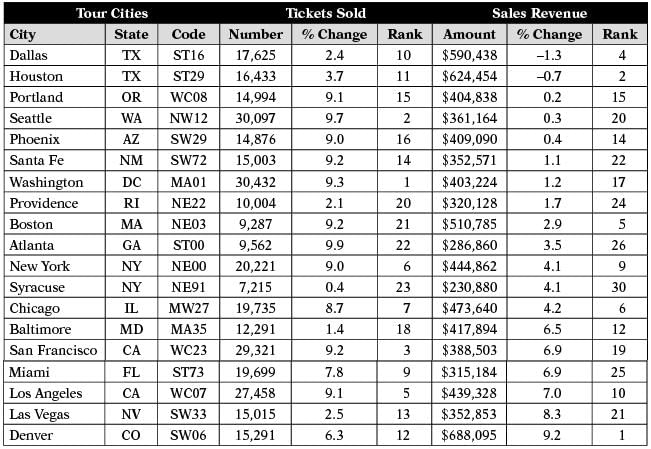
Sorted by Rank of Sales Revenue (Column 9)
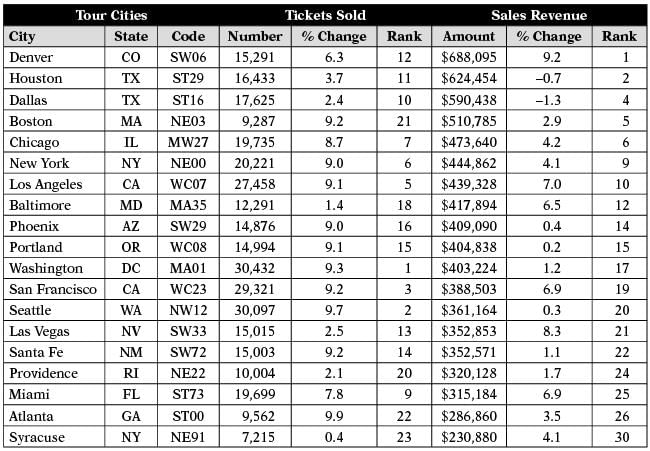
Q. Review each of the statement below. Based on information provided in the table, indicate whether the statement is true or false.
The tour city experiencing the greatest percentage increase in total sales revenue from 2009 to 2010 made more sales revenue in 2010 than any other city on the tour.
The cost of setting up a magazine is Rs.2800. The cost of paper and ink is Rs.80/ 100 copies and printing cost is Rs. 160 / 100 copies. In the last month 2000 copies were printed but only 1500 copies could be sold at Rs. 5 each and rest were destroyed . Total 25% profit on the sale price was realized. There is one more resource of income from the magazine which is advertising. What sum of money was obtained from the advertising in magazine?
The graph shown is a scatter plot with 60 points, each representing the number of quality assurance inspections conducted on products manufactured at 60 different factories, and the corresponding numbers of product recalls experienced by each factory. Each factory conducted a consistent number of quality assurance inspections on all products produced during a one-year period, and the number of product recalls was measured over that same period. The solid line is the regression line, and the dashed line is the line through the points (1, 1) and (7, 5). Select the best answer to fill in the blanks in each of the statements below based on the data shown in the graph.
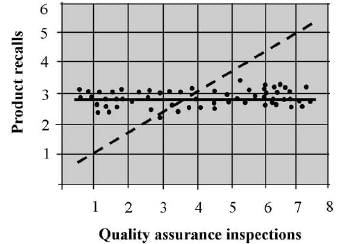
Q. The number of products that received more than seven quality assurance inspections is closest to ________ percent of 60.
Directions: Read the given passage carefully and answer the question as follow:
Ralph Waldo Emerson was born in Boston on May 25, 1803. He was descended from a long line of New England ministers, men of refinement and education. As a school-boy, he was quiet and retiring, reading a great deal, but not paying much attention to his lessons. He entered Harvard at the early age of fourteen, but never attained a high rank there, although he took a prize for an essay on Socrates, and was made class poet after several others had declined. Next to his reserve and the faultless propriety of his conduct, his contemporaries at college seemed most impressed by the great maturity of his mind. Emerson appears never to have been really a boy. He was always serene and thoughtful, impressing all who knew him with that spirituality which was his most distinguishing characteristic.
After graduating from college, he taught school for a time, and then entered the Harvard Divinity School under Dr. Channing, the great Unitarian preacher. Although he was not strong enough to attend all the lectures of the divinity course, the college authorities deemed the name Emerson sufficient passport to the ministry. He was accordingly “approbated to preach” by the Middlesex Association of Ministers on October 10, 1826. As a preacher, Emerson was interesting, though not particularly original. His talent seems to have been in giving new meaning to the old truths of religion. One of his hearers has said: “In looking back on his preaching, I find he has impressed truths to which I always assented in such a manner as to make them appear new, like a clearer revelation.” Although his sermons were always couched in scriptural language, they were touched with the light of that genius which avoids the conventional and commonplace. In his other pastoral duties, Emerson was not quite so successful. It is characteristic of his deep humanity and his dislike for all fuss and commonplace that he appeared to least advantage at a funeral. A connoisseur in such matters, an old sexton, once remarked that on such occasions “he did not appear at ease at all. To tell the truth, in my opinion, that young man was not born to be a minister.”
Q. Which of the following would the author of the passage NOT agree with?
Directions: Read the given passage carefully and answer the question as follow:
Ralph Waldo Emerson was born in Boston on May 25, 1803. He was descended from a long line of New England ministers, men of refinement and education. As a school-boy, he was quiet and retiring, reading a great deal, but not paying much attention to his lessons. He entered Harvard at the early age of fourteen, but never attained a high rank there, although he took a prize for an essay on Socrates, and was made class poet after several others had declined. Next to his reserve and the faultless propriety of his conduct, his contemporaries at college seemed most impressed by the great maturity of his mind. Emerson appears never to have been really a boy. He was always serene and thoughtful, impressing all who knew him with that spirituality which was his most distinguishing characteristic.
After graduating from college, he taught school for a time, and then entered the Harvard Divinity School under Dr. Channing, the great Unitarian preacher. Although he was not strong enough to attend all the lectures of the divinity course, the college authorities deemed the name Emerson sufficient passport to the ministry. He was accordingly “approbated to preach” by the Middlesex Association of Ministers on October 10, 1826. As a preacher, Emerson was interesting, though not particularly original. His talent seems to have been in giving new meaning to the old truths of religion. One of his hearers has said: “In looking back on his preaching, I find he has impressed truths to which I always assented in such a manner as to make them appear new, like a clearer revelation.” Although his sermons were always couched in scriptural language, they were touched with the light of that genius which avoids the conventional and commonplace. In his other pastoral duties, Emerson was not quite so successful. It is characteristic of his deep humanity and his dislike for all fuss and commonplace that he appeared to least advantage at a funeral. A connoisseur in such matters, an old sexton, once remarked that on such occasions “he did not appear at ease at all. To tell the truth, in my opinion, that young man was not born to be a minister.”
Q. Which of the following can most likely be inferred about Ralph Waldo Emerson from the information in the passage?
Directions: Read the given passage carefully and answer the question as follow:
Ralph Waldo Emerson was born in Boston on May 25, 1803. He was descended from a long line of New England ministers, men of refinement and education. As a school-boy, he was quiet and retiring, reading a great deal, but not paying much attention to his lessons. He entered Harvard at the early age of fourteen, but never attained a high rank there, although he took a prize for an essay on Socrates, and was made class poet after several others had declined. Next to his reserve and the faultless propriety of his conduct, his contemporaries at college seemed most impressed by the great maturity of his mind. Emerson appears never to have been really a boy. He was always serene and thoughtful, impressing all who knew him with that spirituality which was his most distinguishing characteristic.
After graduating from college, he taught school for a time, and then entered the Harvard Divinity School under Dr. Channing, the great Unitarian preacher. Although he was not strong enough to attend all the lectures of the divinity course, the college authorities deemed the name Emerson sufficient passport to the ministry. He was accordingly “approbated to preach” by the Middlesex Association of Ministers on October 10, 1826. As a preacher, Emerson was interesting, though not particularly original. His talent seems to have been in giving new meaning to the old truths of religion. One of his hearers has said: “In looking back on his preaching, I find he has impressed truths to which I always assented in such a manner as to make them appear new, like a clearer revelation.” Although his sermons were always couched in scriptural language, they were touched with the light of that genius which avoids the conventional and commonplace. In his other pastoral duties, Emerson was not quite so successful. It is characteristic of his deep humanity and his dislike for all fuss and commonplace that he appeared to least advantage at a funeral. A connoisseur in such matters, an old sexton, once remarked that on such occasions “he did not appear at ease at all. To tell the truth, in my opinion, that young man was not born to be a minister.”
Q. Why does the author use the following line in the passage —‘Emerson appears never to have been really a boy’?
During medieval times, the administrative system was organized such that jobs were traditionally held within the same family. The eldest son of the village's blacksmith will take up his father’s business and become the next blacksmith. The other sons would join the army or serve the king in some fashion while the daughters did what their mother did. Although the world has undergone innumerable changes, the dynastic system has not undergone any change whatsoever. Children who have fathers who played major league baseball are 800 times more likely than other kids to become major league players themselves.
Q. Which of the following best refutes the author's reasoning?
The flood of home foreclosures that followed the large economic recession in 2008 caused housing prices to drop precipitously, which lead to the writing down of mortgage backed securities, and, to fears of a Great Depression-like downward spiral.
Unlike the Battle of Midway, which historians regard as a pivotal moment in World War II, historians regard the Battle of Debrecen as of marginal importance in determining the final outcome of World War II.
AMD employees used their creativity, intellect, and ingenuity to develop faster processors than those offered by many competitors, to enable them to gain substantial market share from rival firm Intel.
The Battle of Bull Run, which took place on July 21, 1861 near the town of Manassas, an important event in American history in that this historic event was the first major ground battle of the Civil War, which resulted in over 500,000 deaths and a turning of the tide against the practice of slavery.
Under the provisions of the United States Constitution and the laws of the United States, the Federal government cannot detain an American citizen indefinitely without cause and is required either to bring charges against the individual being held, in which case he is entitled to a lawyer, or that the government must release him.
x is a positive integer divisible by 4; as x increases from 1824 to 1896, which of the following must decrease?
I. 4x2 - 4x + 4
II. -10 - 1/x2
III. 4/x2
If there are 85 students in a statistics class and we assume that there are 365 days in a year, what is the probability that at least two students in the class have the same birthday (assuming birthdays are distributed independently)?
Given below is a question and two statements numbered I and II given below it. You have to decide whether the data provided in the statements is sufficient to answer the question. You should use the given data and your knowledge of Mathematics to choose between the possible answers.
What is the value of two digit natural number N?
I. N is a mutiple of 13.
II. N is not a composite number.
If (2439 + 18z)(81-18z)(2715 - 9z) = 1, what is the value of z?
Point a is the center of both a circle and a square. The circle, which is fully shown above, is inscribed in the square and the circle is tangent on all sides with the square, which is only partially shown and has both the x-axis and the y-axis as sides. The origin (0,0) is the bottom-left corner of the square and the line DE is a diagonal of the square. If the x-coordinate of point a is x1, what is the area of the gray shaded region between the circle and the origin (0,0)?

Directions: Each Data Sufficiency problem consists of a question and two statements labeled (1) and (2), that provide data. Based on the data given plus your knowledge of mathematics and everyday facts, you must decide whether the data are sufficient for answering the question. The five answer choices are the same for every data sufficiency question.
A codebreaking device is made up of a rectangular box filled with x cylinders of ball bearings placed together such that the diameter of the bearings and the cylinders are equal, and the cylinders line up evenly, touching, with no extra room inside the device. If the cylinders are the same height as the box, and the box is 18 inches long and 10 inches wide, what’s the value of x?
(1) 9 cylinders can line up along the length of the box.
(2) Each ball bearing has a radius of 1.
Directions: Each Data Sufficiency problem consists of a question and two statements labeled (1) and (2), that provide data. Based on the data given plus your knowledge of mathematics and everyday facts, you must decide whether the data are sufficient for answering the question. The five answer choices are the same for every data sufficiency question.
J and K are positive numbers. Is J/K > 1?
(1) JK < 1
(2) J - K > 0
Directions: Each Data Sufficiency problem consists of a question and two statements labeled (1) and (2), that provide data. Based on the data given plus your knowledge of mathematics and everyday facts, you must decide whether the data are sufficient for answering the question. The five answer choices are the same for every data sufficiency question.
A new Coffee Bean & Tea Leaf coffee drink consists only of certain amounts of espresso and sugar. What is the ratio of espresso to sugar in the new drink?
(1) There are 15 ounces of sugar in 35 ounces of the new drink.
(2) There are 40 ounces of espresso in 70 ounces of the new drink.
Directions: Each Data Sufficiency problem consists of a question and two statements labeled (1) and (2), that provide data. Based on the data given plus your knowledge of mathematics and everyday facts, you must decide whether the data are sufficient for answering the question. The five answer choices are the same for every data sufficiency question.
How many in a group are women with blue eyes?
(1) Of the women in the group, 5 percent have blue eyes.
(2) Of the men in the group, 10 percent have dark-colored eyes.
Directions: Each Data Sufficiency problem consists of a question and two statements labeled (1) and (2), that provide data. Based on the data given plus your knowledge of mathematics and everyday facts, you must decide whether the data are sufficient for answering the question. The five answer choices are the same for every data sufficiency question.
On a soccer team, one team member is selected at random to be the goalie. What is the probability that a substitute player will be the goalie?
(1) One-sixth of the team members are substitute players.
(2) 18 of the team members are not substitute players.




 ; f(-1) =
; f(-1) =















